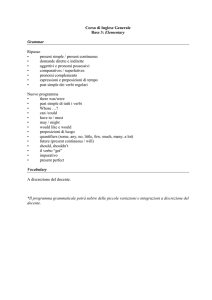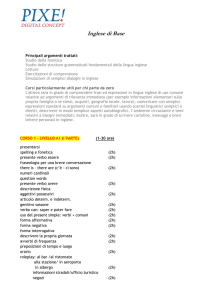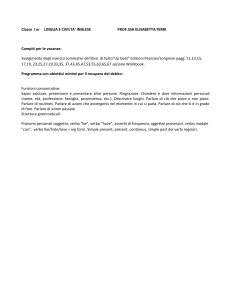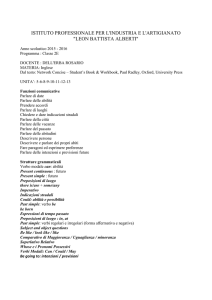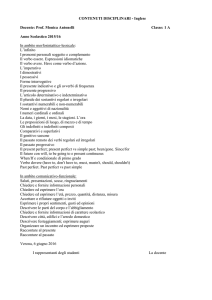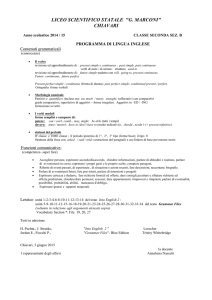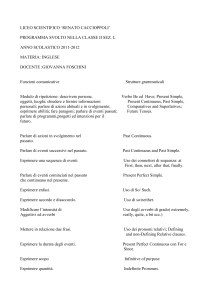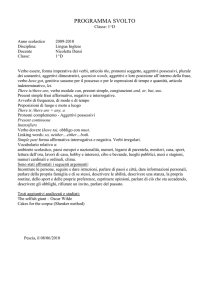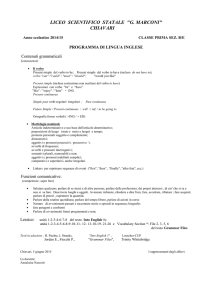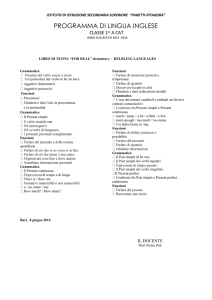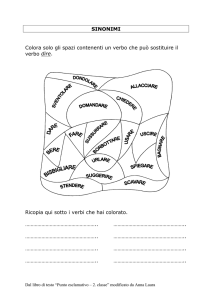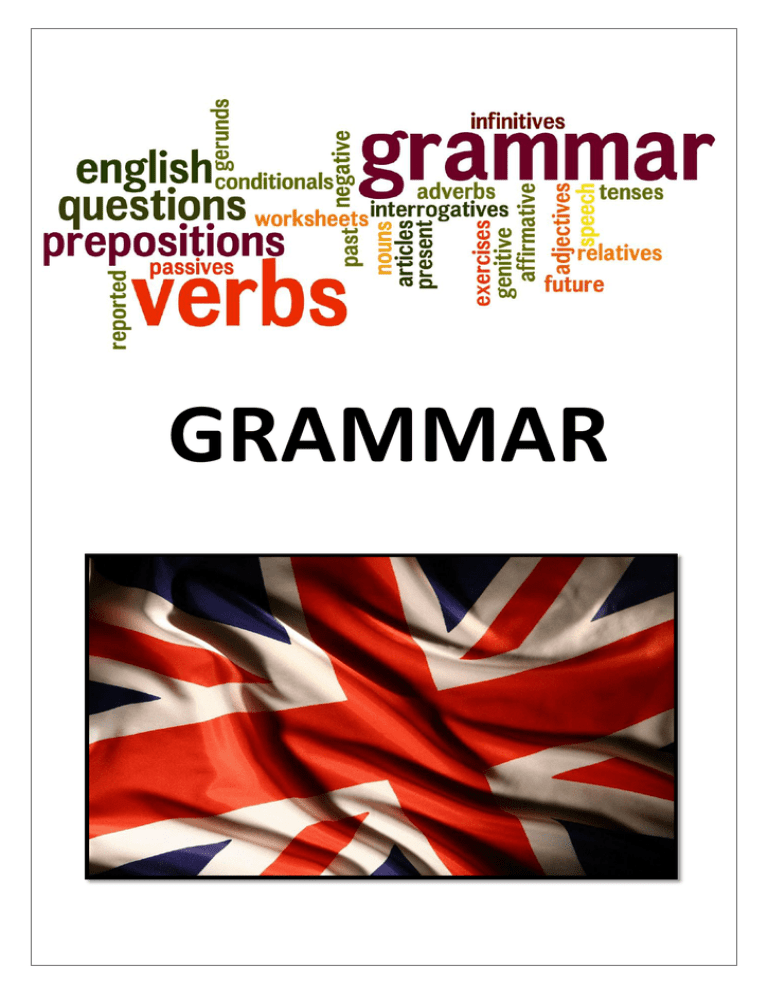
GRAMMAR
To bring/brought/brought
To take/took/taken
Portare vicino all’interlocutore;
Portare lontano dall’interlocutore;
LOVE e FRIENDSHIP sono UNCOUNTABLE, non vogliono l’articolo;
Il plurale dei nomi che terminano in “ef” o “fe” si formano togliendo ef - fe e aggiungendo “ves”
Ex. Thief Thieves
Knife Knives
Wife Wives
Roof Roofs
PERSONAL PRONOUNS (subject and object )- POSSESSIVES (adjectives and pronouns)
−
Gli aggettivi e i pronomi possessivi rimangono invariati per genere e numero;
Personal pronouns
Objective pronouns
Personal adjectives
Possessive pronouns
I (io)
Me (me/mi)
My (mio)
Mine (mio)
You (tu)
You (te/ti)
Your (tuo)
Yours (tuo)
He (lui)
Him (lui/sé/lo/gli)
His (di lui)
His (di lui)
She (lei)
Her (lei/sé/la/le)
Her (di lei)
Hers (di lei)
It (esso)
It (esso)
Its (di esso)
Its (di esso)
We (noi)
Us (noi/ci)
Our (nostro)
Ours (nostro)
You (voi)
You (voi/vi)
Your (vostro)
Yours (vostro)
They (essi)
Them ( loro/sé/li/le)
Their (loro)
Theirs (loro)
− -Davanti gli aggettivi e ai pronomi possessivi non si mette mai l’articolo:
− Ex. 1) La mia macchina è rossa. My car is red.
− -L’aggettivo possessivo si mette sempre davanti al nome a cui si riferisce, mentre il pronome
possessivo
− sostituisce il nome a cui si riferisce:
Ex. 1) Quella è la tua bici. That is your bike. (aggettivo)
2) Quella bici è tua. That bike is yours. (pronome)
- Il complemento è generalmente introdotto da una preposizione:
Ex. 1) Questo regalo è per lui. This presenti s for him.
WHOSE
Whose? = Di chi? Vuole subito dopo l’oggetto;
Ex. 1) Di chi è quella borsa? Whose bag is that?
2) E’ mia. It’s mine./This is my bag.
3) E’ di mia mamma. complemento di specificazione.
N.B. In inglese il complemento di specificazione italiano si traduce con il genitivo sassone solo se il
possessore è una persona (tranne in alcuni casi) mentre se il possessore è un oggetto, si usa la
preposizione of.
Grammar
Pag. 2
COME SI COSTRUISCE IL GENITIVO SASSONE?
POSSESSORE + ‘S + OGGETTO POSSEDUTO
Ex. 1) La macchina di mio padre è in garage. My father car is in the garage.
a) Se il possessore è espresso con un sostantivo plurale regolare si aggiunge solo l’apostrofo:
Ex. 1) La macchina dei miei genitori è in garage. My parents’ car is in the garage
b) Se l’oggetto è posseduto in comune da due diversi possessori, ‘s si aggiunge solo al secondo posto:
Ex. 2) La macchina di mio padre e di mia madre è in garage. My father and mother’s car is …
c) Se l’oggetto è posseduto distintamente dai due possessori, si aggiunge ‘s a entrambi:
Ex. 3) L macchina di Mark e la macchina di George è rossa. Mark’s and George’s car is red.
IL DOPPIO GENITIVO
Ex. 1) Uno dei miei amici è ammalato. One of my friends is ill./A friend of mine is ill.
2) Alcuni dei suoi CD sono rotti. Some of his CDs are broken./Some CDs of his are broken.
AGGETTIVI DIMOSTRATIVI
Vicinanza
Lontananza
Singolare
This (questo/a)
That (quello/a)
Plurale
These (questi/e)
Those (quelli/e)
SINGOLARE
PLURALE
There is (c’è)
There are (ci sono)
C’E`/CI SONO
Ex. 1) There is a picture on the wall. C’è un quadro sul muro.
2) There isn’t a picture on the wall. Non c’è un quadro sul muro.
3) Is there a picture on the wall? C’è un quadro sul muro?
4) There are some picture on the wall. Ci sono dei quadri sul muro.
5) There aren’t any picture on the wall. Non ci sono quadri sul muro.
6) Are there any picture on the wall? Ci sono dei quadri sul muro?
Grammar
Pag. 3
PREPOSIZIONI
- IN: dentro
- OVER/ABOVE: sopra senza contatto
- BEHIND: dietro
- IN THE MIDDLE: nel mezzo
- IN FRONT OF: davanti, di fronte
- AMONG: tra tanti
- UP: su
- AT: a/presso
- WITH: con (le persone)
- ON: sopra con contatto
- BY: con (di mezzo on foot)
- NEAR: vicino
- NEXT TO: accanto
- OPPOSITE: di fronte, faccia a faccia -BETWEEN: tra due
- ON THE RIGHT/LEFT: a destra /sinistra
- DOWN: giù
- BELOW: sotto
AVVERBI
- UPSTAIRS: al piano superiore
- OUTSIDE/OUT: fuori
- DOWNSTAIRS: a pianterreno
- INSIDE
MODAL AUXILIARY CAN
Can si traduce in italiano con il verbo potere ed è in inglese un verbo modale ovvero un verbo
autosufficiente ( che non richiede l’uso di ausiliari );
E` seguito dall’infinito del verbo senza il “to”:
Ex. 1) I can speak German.
Alla forma negativa si può esprimere con le forme cannot oppure can’t.
Alla forma interrogativa non richiedono l’ausiliare e si forma così: Can I … ? Can you … ?
Nelle short answers can si usa come nell’esempio che segue:
risposta affermativa: Yes, I can.
risposta negativa: No, I can’t.
Can si usa per:
1) chiedere o concedere un permesso in modo informale;
2) esprimere una capacità (saper fare qualcosa, avere la capacità materiale e mentale di fare qualcosa,
riuscire a farla);
SIMPLE PRESENT
Ex. 1) “Dove sei?”
“Sono in cucina. Faccio colazione.”
“Faccio sempre colazione la mattina.”
LE TRE DOMANDE DA PORSI SEMPRE
QUANDO?
CHE FORMA?
CHE SOGGETTO?
Grammar
Pag. 4
PRESENTE INDICATIVO Simple present:
1) azione di abituale routine;
2) presente narrativo (articolo di giornale);
Present continuous/progressive:
1) azione in corso di svolgimento in un preciso momento del presente (stare + ger.);
2) azione futura programmata;
Per capire se usare il Simple Present o il Present Progressive sono di fondamentale importanza gli avverbi
di tempo, gli avverbi di frequenza ma, soprattutto, il contesto in cui è inserita la frase;
COME SI COSTRUISCE?
COSTRUZIONE
Forma affermativa
Forma negativa
I work
You work
He/She/It works
We work
You work
They work
I don’t work
You don’t work
He/She/It doesn’t work
We don’t work
You don’t work
They don’t work
Forma interrogativa
Do I work?
Do you work?
Does he/she/it work?
Do we work
Do you work
Do they work
- Alla 3^ persona singolare si aggiunge -s o –es (quando il verbo termina in s/ss/sh/ch/z/x);
- In inglese bisogna sempre esprimere e il soggetto tranne che all’imperativo;
- Le forme contratte non si possono usare nel linguaggio formale (scritto o rivolto a persone più adulte o
gerarchicamente superiori)
VERBI
VERBI AUSILIARI
Verbi autosufficienti/autonomi come to be, have got e i modali
(will, would, can, could, may, might, must, should)
VERBI NON AUSILIARI Verbi regolari, non sono autosufficienti cioè quindi richiedono l’utilizzo di
ausiliari per costruire le forme interrogative, negative ed interrogative-negative
Le short answers con il simple present si formano con l’affermazione o la negazione (Yes, … /No, …)
seguita dal soggetto e l’ausiliare (do oppure does/don’t/doesn’t)
Grammar
Pag. 5
SIMPLE PRESENT VS PRESENT PROGRESSIVE
Forma affermativa
Forma negativa
Forma interrogativa
I am working
You are working
He/She/It is working
We are working
You are working
They are workig
I am not working
You aren’t working
He/She/It isn’t working
We aren’t working
You aren’t working
They aren’t working
Am I working?
Are you working?
Is he/she/it working?
Are we working?
Are you working?
Are they working
Ex. 1) Now they are eating an ice-cream. In questo momento stanno mangiando un gelato. (p.p.)
Il present progressive è utilizzato per esprimere
un’azione che è in corso di svolgimento in un determinato momento del presente;
2) They eat an ice-cream every afternoon. Mangiano gelato ogni pomeriggio. (simple present)
Il present simple è utilizzato per esprimere un’azione abituale;
3) This afternoon I’m going to the dentist. Questo pomeriggio andrò dal dentista. (p.p)
Il present progressive è utilizzato per esprimere un’azione futura programmata.
4) Next week I’m going to the dentist. La prossima settimana andrò dal dentista (present progressive)
Il present progressive è utilizzato per esprimere un’azione futura programmata.
STRUTTURA DEL PRESENT PROGRESSIVE
Le short answers con il present progressive si formano con la affermazione yes o la negazione no seguita
dal soggetto e dall’ausiliare essere nella forma richiesta.
AVVERBI DI FREQUENZA
ALWAYS: sempre
SOMETIMES: qualche volta
OCCASIONALLY: in qualche occasione
OFTEN: spesso
RARELY/ SELDOM: raramente
GENERALLY: generalmente
USUALLY: solitamente
NEVER/EVER: mai
Gli avverbi di frequenza si mettono sempre prima del verbo e sempre dopo i verbi ausiliari e modali.
E’ consigliabile posizionare gli avverbi e le espressioni di tempo alla fine della frase
Grammar
Pag. 6
PREPOSIZIONI DI TEMPO
Davanti alle parti del giorno: IN = in the morning, in the afternoon, in the
evening MA fa eccezione At night
Davanti ai Mesi = IN (in August)
Davanti ai Giorni della settimana= ON (on Monday)
Davanti agli anni = IN (in 2009)
Davanti alle date = ON (On the 21st of June)
Davanti alle Festività = (at Christmas; at Easter)
Davanti alle stagioni = IN (in Spring; In Summer; in Autumn; in Winter)
Davanti alle ore = AT (at 12:00)
TO HAVE
Have got (British English ) Ex. 1) I have got a car./I haven’t got a car./Have I got a car?
Have (American English ) Ex. 2) I have a car./ I don’t have a car./Do I have a car?
Usi particolari di to have:
A)
B)
C)
D)
E)
F)
To have breakfast fare colazione
To have lunch
pranzare
To have dinner
cenare
To have a party
fare una festa
To have a shower fare una doccia
To have a bath fare un bagno
WH QUESTIONS
Who = chi?
What = che cosa?
- Se who o what nella domanda hanno funzione di soggetto, non si usano gli ausiliari do e does ma la frase
deve essere costruita con il verbo alla forma affermativa.
Ex. 1) Chi prepara la colazione la mattina? Who makes breakfast in the morning? - Mum does.
Ex. 1) Che cosa succede se scogli il ghiaccio? What happens if you melt ice?
Grammar
Pag. 7
- Se in generale i pronomi interrogativi nella domanda hanno funzione di complemento, la preposizione
che introduce tale complemento occupa l’ultima posizione nella domanda;
Ex: Who did you go to the party with?
Where dove?
Ex. 1) Where are you from? Di dove sei?
Ex. 2) Who do you go out with on Saturday night? Con chi esci sabato sera?
When quando?
Why perché?
How? come?
PARTITIVI
Indicano una parte, una quantità senza precisarla (alcuni, un po’, dei, …)
SOME
Si usa nelle frasi affermative davanti a sostantivi countable o uncontable.
Si può usare anche nelle frasi interrogative ma solo se queste indicano un’offerta o una richiesta;
Ex. 1) Would you like some milk in the coffe? Vuoi del latte nel caffe?
Composti di some:
Somebody
Someone (qualcuno)
Some where (da qualche parte)
Something (qualcosa)
Some how (in qualche modo)
ANY
Si usa nelle frasi interrogative generiche e nelle frasi negative con verbo negativo, davanti ai sostantivi
countable o uncontable;
Composti di any:
Anybody (nessuno/chiunque)
Anywhere (da nessuna parte/ovunque)
Anything (niente/qualsiasi cosa)
Ex. 1) Is there any milk in the fridge? C’è del latte in frigo?
2) Sì, ce n’è. Yes, there is some.
3) No, non ce n’è. No, there isn’t any.
Grammar
Pag. 8
NO
Si usa per esprimere frasi negative assolute con un con il verbo coniugato alla forma affermativa.
Ex. 1) There isn’t any milk. There is no milk
Composti di no:
Nobody/No one (nessuno)
Nowhere (da nessuna parte)
Nothing (niente)
Ex. 1) Today there insn’t anybody at the park. There is nobody at the park
NONE
Si usa nelle frasi negative con il verbo coniugato alla forma affermativa
Ex. 1) No, non ce n’è. No there isn’t any./ No there’s none.
Ex. 2) None of us/them/you None of my friends
MOLTO
A lot of: molto/i/e si usa nelle frasi affermative e davanti ai sostantivi countable and uncountables
A lot: molto si usa dopo i verbi e nelle frasi affermative;
Ex. 1) She reads a lot. Lei legge molto.
Much: molto Si usa nelle frasi negative ed interrogative e davanti a sostantivi UNCOUNTABLE
Ex. 1) I haven’t got much time today. Non ho molto tempo oggi.
Many: molti/e si usa nelle frasi negative e interrogative e davanti a sostantivi COUNTABLE
Ex. There aren’t many mistakes in your test. Ci sono molti errori nel tuo test
POCO - POCHI
A little: un po’ si usa con i sostantivi singolari e con verbi;
A few: pochi/e si usa con sostantivi plurali;
TOO AND ENOUGH
TOO: si usa per esprimere il significato di troppo davanti ad aggettivi e avverbi
Ex. 1) You are too tall. Sei troppo alto.
2) The dress is too expensive. Il vestito è troppo costoso.
TOO MUCH: troppo davanti agli UNCOUNTABLE NOUNS
Ex. 1) There is too much noise in this class. C’è troppo rumore in questa classe.
Grammar
Pag. 9
TOO MANY: troppo davanti ai COUNTABLE NOUNS
Ex. 1) There are too many people at the market. Ci sono troppe persone al supermercato.
ENOUGH: abbastanza + COUNTABLE and UNCOUNTABLE NOUNS
ENOUGH si usa prima degli aggettivi
Ex. 1) There are enough oranges for tomorrow
2) This dress is cheap enough
SIMPLE PAST
Il simple past si usa per indicare un’ azione cominciata e conclusa nel passato
Il contesto o gli avverbi e le espressioni di tempo devono riferirsi al passato(dal contesto e/o da avverbi di
tempo determinati);
Ex. 1) Marta è andata a scuola avverbio di tempo INDETERMINATO
Mary has gone to school.
EX: 2) Marta è andata a scuola stamattina (stamattina avverbio di tempo DETERMINATO azione finita
e conclusa) = Marta went to school this morning.
Pertanto il passato prossimo in italiano si traduce con il simple past se fa riferimento ad un’azione passata,
conclusa.
SIMPLE PAST di TO BE:
Forma affermativa
Forma negativa
Forma interrogativa
I was
I wasn’t
Was I?
You wew
You weren’t
Were you?
He/She/It was
He/She/It weren’t
Was he/she/it
We were
We weren’t
Were we?
You were
You weren’t
Were you?
They were
They weren’t
Were they?
- Forma affermativa: Soggetto + Verbo + complemento oggetto;
- Forma negativa:
Soggetto + didn’t + forma base del verbo
- Forma interrogativa: (pronome interrogativo) + did + soggetto + forma base + del verbo
- Short answer: yes, I did / No I didn’t
Al simple past I verbi i regolari si traducono aggiungendo al bare infinitive –ed (o se finiscono in e si
aggiunge solo –d), mentre con i verbi irregolari si utilizza la seconda forma del paradigma;
COMPARATIVI
Grado “0” funzione predicativa: Lui ha una bici rossa. = He’s got a red bike.
funzione nominativa: La sua bicicletta è rossa. = His bike is red.
Comparativo maggioranza/uguaglianza/minoranza
Superlativo relativo: Lui è il più alto della classe./Lei è la meno attenta di tutti
assoluto: Lui è bellissimo
Grammar
Pag. 10
Comparativi:
Aggettivi e avverbi monosillabici “con una sola o due sillabe terminanti in Y o ER ” (big/young/old) =
Costruzione = agg./avv. + er + than
Ex. 1) He’s older than me.
Ex: 2) This room is bigger than the other.
Aggettivi plurisillabico “ con più sillabe ” = more + agg./avv. + than
Eccezioni: easy = easier
Ex. 1) English is easier than German.
Aggettivi irregolari:
A)
Good/Better/The best (aggettivo)/ Well (Avverbio)
B)
Ex. 1) He’s a good teacher./He teaches well.
B) Bad/Worse/The worst (aggettivo)
C) Old/Older/Eleder(per le persone)/The oldest
D) Far/Farther/Further/The farthest (più distante in senso spaziale); Further; the furthest (in senso
temporale = ulteriore)
Comparativi di maggioranza con verbi:
verbo + more + than
Ex. 1) Io studio più di te. I study more than you.
Ex. 2) Noi giochiamo meglio di voi. We play better than you.
more + nome + than
Comparativi di maggioranza con sostantivi:
Ex. 1) Ho più denaro di te. I’ve more money than you.
SUPERLATIVI
- Aggettivi e/o avverbi monosillabico o bisillabo terminante in Y o ER
(big/young/old) =
The + agg./avv. + EST in/of
Ex. 1) Piero is the tallest guy in the class. Pierò è il più alto in classe.
plurisillabico =
The most + agg./avv. + in/of
Ex. 1) This is the most expansive gift in the shop. Questo è il più costoso …
Grammar
Pag. 11
FUTURES
1. PRESENT PROGRESSIVE (con funzione di futuro pr);
2. FUTURE CONTINUOUS;
3. SIMPLE PRESENT (con funzione di futuro);
4. TO BE GOING TO;
5. SIMPLE FUTURE;
6. FUTURE PERFECT (futuro anteriore);
Present continuous indica un’azione futura programmata, “certa” solitamente accompagnata da un
avverbio di tempo:
Ex. 1) Sta sera incontrerò i miei amici. I’m meeting my friends tonight.
To be going to “avere intenzione di” = futuro intenzionale:
Ex. 1) Ho intenzione di comprare una nuova macchina. I’m going to buy a new car.
Stare per, indica un’azione imminente, che sta per accadere:
Ex. 1) It is going to rain. Sta per piovere.
Simple future
Indica un’azione futura che avverrà indipendentemente dalla volontà del soggetto:
Ex. 1) In giugno compirò 38 anni. In June I’ll be 38
Indica una previsione: un’azione futura che il soggetto ritiene probabile
Ex. 1) Domani pioverà. It will rain tomorrow.
Ex. 2) Nel 2010 ci saranno più disoccupati. In 2010 there will be more unemployed.
Ipotetica del I TIPO :
Simple Future (frase principale) + if + Simple Present (frase secondaria)
Ex. 1) Se domani pioverà, resteremo a casa. If it rains tomorrow, we will stay at home
Ex. 2) Non passerai l’esame se non studi. If you don’t study you won’t pass the exam.
Indica una promessa
Ex. 1) I promise you I’ll write you. Ti prometto che ti scriverò.
Indica un’azione futura che è il risultato di una decisione immediata:
Ex. 1) Fa caldo. Apro la finestra. It’s hot here. I’ll open the window.
IL GENITIVO SASSONE
Il genitivo sassone è una forma linguistica che serve per esprimere: IL POSSESSO DA PARTE DI UNA
PERSONA DI UNA COSA
Ex. 1) The legs of the table are short. . Le gambe del tavolo sono corte.
Ex: 2) Patrick’s ipod is an Apple. . L’ipod di Patrick è della Apple.
Grammar
Pag. 12
AGGETTIVI POSSESSIVI
Gli aggettivi possessivi sono sempre seguiti da un nome, i pronomi mai.
Ex. 1) Il mio gatto è vecchio (aggettivo), il tuo no (pronome). My cat is old, yours no.
In inglese gli aggettivi possessivi sono immutabili per genere e numero;
Davanti agli aggettivi possessivi non si mette mai l’articolo;
I pronomi possessivi non sono mai seguiti da un nome;
IL COMPARATIVO
I comparativi sono forme del discorso che servono a mettere in relazione 2 cose o 2 persone tra il loro.
Il superlativo invece mette in relazione una cosa o una persona con un gruppo di cose o persone;
Il comparativo di maggioranza, degli aggettivi si costruisce:
A) Negli aggettivi monosillabi o bisillabi terminanti in “y” e “er”, aggiungendo ER al grado positivo
dell’aggettivo:
Ex. 1) My room is tidier than Patrick’s room
N.B Il secondo termine di paragone è sempre introdotto dalla parola “than”;
B) Con gli aggettivi plurisillabi il complemento di maggioranza di costruisce premettendo “more” seguito
dall’aggettivo al grado positivo e dal secondo termine di paragone “than”:
Ex. 1) The book on the table is more expansive than the one in the shelf.
Il libro sul tavolo è più costoso di quello nella mensola.
WHICH
Si usa per porre all’interlocutore una scelta. Risponde alla domanda: Quale fra tante?
IL SUFFISSO - ER
Il suffisso -
REGOLE DI BUONA LETTURA
Il pronome complemento, così come la preposizione, vanno sempre letti attaccati al verbo;
Il complemento oggetto va sempre letto attaccato al verbo;
Le parole di origine anglosassone hanno sempre l’accento sulla prima sillaba.
Grammar
Pag. 13
SIMPLE PRESENT
ASPETTO per aspetto di un verbo si intende: l’immagine mentale che l’interlocutore costruisce
Mentalmente mentre ascolta un messaggio.
Quando si studia un tempo verbale (verb tense) si considerano i seguenti elementi
1. ASPETTO;
2. USO;
3. COSTRUZIONE;
SIMPLE PRESENT
1. ASPETTO
Il simple present esprime l’aspetto simple del verbo.
L’aspetto simple restituisce all’interlocutore l’immagine di un’azione completa, immaginata dall’inizio alla
fine. Crea un effetto di completezza e stabilità.
2. USO
Il present simple si usa per esprimere:
A) Azioni abituali che il soggetto compie con una certa frequenza, abitudine, regolarità;
Ex. 1) I don’t go to school on Sundays. Non vado a scuola il sabato.
B) Per esprimere stati che non cambiano:
Ex. 1 ) L’acqua bolle a 100 C°. Water boils at 100 C°.
C) Per esprimere emozioni, sentimenti, stati d’animo e mentali (penso, credo … ):
Ex. 1) I love music./I hate noise./I love him./I hate her.
D) Orari di mezzi pubblici:
Ex. 1) Il treno da Udine arriva alle 3:00, quello delle 14:40. The twenty to three train arrives at
Three
3. COSTRUZIONE
Le frasi affermative con il present simple si formano:
1° POSTO Soggetto;
2° POSTO Verbo (infinito del verbo senza il to tranne che alla 3^ persona a cui si aggiunge un -s) ;
3° POSTO Complemento oggetto;
4° POSTO Resto della frase;
Le frasi interrogative con il present simple si formano:
1° POSTO Do/does;
2° POSTO Soggetto;
3° POSTO Infinito del verbo senza il to;
4° POSTO Resto della frase;
Grammar
Pag. 14
Le frasi interrogative introdotte da pronome interrogativo con il present simple si formano:
1° POSTO Pronome interrogativo;
2° POSTO Do/does;
3° POSTO Soggetto;
4° POSTO Infinito del verbo senza il to;
5° POSTO Resto della frase;
Le frasi introdotte da pronome interrogativo che è soggetto della frase con il present simple si formano:
1° POSTO Pronome interrogativo;
2° POSTO Verbo coniugato alla forma affermativa;
3° POSTO Complemento oggetto;
4° POSTO Resto frase;
PRESENT PROGRESSIVE
Il present progressive sottolinea l’aspetto progressive del verbo.
1. ASPETTO
L’aspetto progressive indica che l’interlocutore, ovvero chi riceve il messaggio, percepisce l’azione recitata
dal verbo in una sua parte, non in modo completo.
Ex. 1) Laggiù stanno parlando. They are talking over there.
2. USO
Il present progressive si usa per esprimere:
A) Azione in corso di svolgimento in un momento ben preciso del presente (adesso, in questo momento ,
ad un’ora ben precisa):
Ex. 1) In questo momento gli studenti stanno scrivendo. The students are writing at the moment.
Ex. 2) Sono le 7:00, mia mamma sta uscendo di casa. It’s 7:00, my mum is going out.
B) La variazione temporanea di una certa routine:
Ex. 1) Di solito mi alzo alle 7:00, ma questa settimana sono in vacanza e mi alzo alle 10:00. I
usually get up at 7:00, but this week I’m getting up at 10 because I’m on holiday.
C) Un’azione futura programmata:
Ex. 1) Domani andrò al cinema con Fred. Tomorrow I’m going to the cinema with Fred.
MOLTO DOPO I VERBI
Generalmente si usa a lot oppure much per dire “molto” dopo i verbi:
Ex. 1) I read a lot
2) I eat much
“Molto” dopo i verbi to stay,to try,to work si traduce con hard
Grammar
Pag. 15
I verbi terminanti in consonante e preceduti da una sola vocale tonica (accentata), raddoppiano la
consonante finale prima di aggiungere le desinenze dei verbi
FORMA PASSIVA DEI VERBI
Quando ci si aspetta o attende che una persona diversa dal soggetto compia o faccia qualche cosa si usa
la costruzione
VERBO + COMPLEMENTO OGGETTO + INFINITO:
To expect (aspettarsi)
Ex 1: I expect him to return my love
Ex 2: Voglio che tu faccia attenzione = I want you to be careful
Ma:
I expect = I’ll have a nice time (Mi aspetto di divertirmi).
I verbi “to start” e “to finish” reggono sempre il gerundio.
Nella lingua scritta, non si usano mai la forma contratta;
I verbi che terminano in e muta, la perdono prima di aggiungere –ing
To come = coming
MA
to be = being
PREPOSIZIONI DI LUOGO
La preposizione to indica il moto a luogo, ovvero uno spostamento fisico o figurato;
N.B. La parola HOME rifiuta il to con i verbi di MOTO
Ex. 1) I go home every day, after school.
Ex. 2) He was exhausted and decided to go back home.
La preposizione into viene utilizzata per esprimere:
A) un moto entro luogo chiuso = quando si entra in un luogo chiuso
Ex. 1) I go into the garden when I want to have a rest. Vado in giardino quando voglio riposarmi.
ARTICOLO E NOMI PROPRI
I nomi propri GENERALMENTE rifiutano l’articolo determinativo “the” tranne che quando si tratta di un
nome proprio è strutturato, ovvero costituito da parti vuole l’articolo determinativo THE
Ex. 1) the USA.
Ex. 2) Which countries have you visited so far? I visited Germany, Italy and the UK. (the United
Kingdom).
Grammar
Pag. 16
FUTURE PROGRESSIVE
Il future progressive si usa per esprimere:
un’azione futura, che sarà in corso di svolgimento in un momento ben preciso del futuro:
Ex. 1) This evening at 6 o’clock p.m., I’ll be driving with Maria
USO DEI POSSESSIVI
Si USA IL POSSESSIVO:
Davanti alle parti del corpo:
Davanti ai propri capi di abbigliamento :
Davanti a nomi relativi alla propria parentela
Ex: A: His nose is small
Ex: B: Your coat is really trendy.
Ex: C: Their parents are rather old.
VOCABULARY
TO JOIN + complemento oggetto andarsene insieme a qualcuno a fare qualcosa;
Ex. 1) We’re going to the cinema this afternoon, will you join us?
- Any: in frase affermativa significa “qualsiasi cosa”/ “ qualsiasi tipo di”;
La frase “ andare a” in inglese si traduce:
TO GO AND + infinito del verbo senza il to ;
Gli avverbi di modo si costruiscono aggiungendo -ly all’aggettivo al grado positivo. Ex: lucky luckily
IPOTETICHE – IF CLAUSES
IPOTETICA DELLA PROBABILITA’: 1° grado Futuro semplice (principale)/ Simple present
(secondaria)
L’ipotetica del primo tipo esprime un’ipotesi che il soggetto ritiene probabile
IPOTETICA DELLA POSSIBILITA’: 2 grado
Conditional Present (principale) /simple Past (secondaria)
L’ipotetica del secondo tipo esprime un’ipotesi che può verificarsi o meno (non si sa) oppure una
situazione immaginaria al presente ma che potrebbe anche verificarsi
EX: Se fossi ricco , comprerei un cavallo. If I were rich, I would buy a horse.
Grammar
Pag. 17
DIFFERENZA TRA PRESENT PERFECT E PRESENT PERFETCT PROGRESSIVE
Duration form (forma di durata) :
Esistono due forme di durata:
A) Forma di durata al presente (esprime un’azione che iniziata nel passato, continua anche nel presente)
Ex. 1) Studio inglese da 10 anni. (da quanTo?) - Da 10 anni
((Ho cominciato a studiare nel passato e lo sto ancora studiando adesso) COMPLEMENTO DI TEMPO
CONTINUATO (FOR)
Ex. 2) How long have you been studyng English? - I have been studying English for 10 years.
Ex. 3) Da quanDo studi inglese? - Lo studio dal 1999 COMPLEMETO DI TEMPO DETERMINATO (since)
Ex. 4) Since when have you been studying English? - I have been studying SINCE 1999.
La forma di durata al presente si esprime con il present perfect progressive
HAVE/HAS + BEEN + ING
B) Forma di durata al passato: (esprime un’azione che iniziata nel passata, è continuata per un certo
periodo di tempo, fino a quando è stata interrotta da un’altra azione o decisione)
N.B. In italiano la forma di durata al passato è espressa con l’imperfetto
Ex. 1) Studiavo inglese da 10 anni, quando decisi di imparare il tedesco. I had been studying English for
10 years, when I decided to learn German.
Ex. 2) How long had you been studying English when you decided to learn German? Da quanTo ?
COMPLEMENTO DI TEMPO CONTINUATO (For 10 years)
Ex. Since when had you been studying English when you decided to learn German? Da quanDo ?
COMPLEMENTO DI TEMPO DETERMINATO (Since 1999)
HAD + BEEN + ING
La forma di durata al passato si esprime con il past perfect progressive
N.B. La forma di durata al presente si esprime con il PRESENT PERFECT quando è:
A) NEGATIVA Ex. 1) Non piove da 2 mesi. - It hasn’t rained for 2 months.
B) Quando la forma di durata al presente è espressa con verbi di percezione.
I verbi di percezione sono i verbi di non azione (i verbi di azione implicano la volontà)
TO SEE
vedere: percezione
TO LOOK AT guardare: azione
Ex: Non piove da tre mesi: It hasn’t rained for three months
Ex. 1) Lo conosco dal 2001 = I have known him since 2001
Grammar
Pag. 18
FORMA DI DURATA AL PASSATO
La forma di durata al passato si traduce con il PAST PERFECT quando è:
1. negativa
2. espressa con verbi di percezione
Ex 1: He hadn’t seen her since he was a child. (Non lo vedeva da quando era un bambino)
Ex 2 She hadn’t spoken English for three years when she had to because she was in Oxford.
IL FUTURO
Il futuro è il tempo che non esiste. Pertanto la lingua inglese non possiede ausiliari specifici per parlare di
quello che non esiste. Quanti modi ci sono per esprimere azioni future? Infiniti:
A) PRESENT PROGRESSIVI AS FUTURE Uso del presente progressivo con valore di futuro.
Il present progressive si usa per esprimere:
UN AZIONE FUTURA PROGRAMMATA NEL TEMPO bisogna assicurarsi di quale sia l’avverbio di tempo
per capire se si tratta di futuro o presente. Si costruisce coniugando il presente dell’ausiliare ESSERE + il
gerundio:
Ex. 1) What are you doing on Saturday afternoon? complemento di tempo che riguarda il futuro
Con questa domanda si presuppone che l’interlocutore sappia già cosa fare.
B) GOING TO FUTURE Il going to future esprime:
UN AZIONE CHE IL SOGGETTO HA INTEZIONE DI COMPIERE MA NON E’ DETTO CHE LO FARA’
Ex. 1) I’m going to buy a new car.
C) UN AIZONE FUTURA DI CUI SI VEDONO GIA’ I PRESUPPOSTI.
Ex. 1) It’s going to rain.
Ex. 2) Look at the woman. She’s going to have a baby.
D) UN AZIONE CHE E’ SUL PUNTO DI ACCADERE.
Ex. 1) Look! She’s going to fall.
SIMPLE FUTURE
Diversamente dal present progressive utilizzato per esprimere un’azione futura programmata nel tempo e
che sottolinea l’aspetto progressive, il simple future sottolinea l’aspetto simple, ovvero un’azione
percepita nella sua completezza: dall’inizio ala fine.
USO:
Il simple future si usa per esprimere:
A) UN AZIONE FUTURA CHE IL SOGGETTO RITIENE PROBABILE:
Ex. 1) Penso che mi addormenterò. I think I’ll fall asleep.
B) UN’AZIONE CHE ACCADRA’ INDIPENDENTEMENTE DALLA NOSTRA VOLONTA’:
Ex. 1) On the 25th of November I’ll be 53.
C) UN’AZIONE FUTURA CHE E’ IL RISULTATO DI UNA DECIZIONE MOMENTANEA:
Grammar
Pag. 19
Ex. 1) What are you doing this evening? I don’t know. I think I’ll stay home.
D) NELL’IPOTETICA DI 1° TIPO LA FRASE PRINCIPALE:
Ex. 1) Se pioverà, starò a casa. I’ll stay at home, if it rains NELLE IPOTETICHE DEL 1° TIPO, LA FRASE
SECONDARIA VA CONIUGATA AL PRESENTE.
VALE ANCHE PER IL DOPPIO FUTURO:
Ex. 1) Se sarò libera, verrò da te. If I’m free, I’ll come to your house
NOTA BENE:
- Davanti ai nomi di vie si usa sempre la preposizione “ at “;
- Per tradurre molto davanti a nomi contabili nelle frasi affermative si usa “a lot of”;
USI PARTICOLARI:
Quando si deve utilizzare il going to future con il verbo to go, in inglese si usa il present progressive;
Ho intenzione di andare a Roma: I am going to Rome
QUESTION TAGS: servono a ricevere l’approvazione o meno dei nostri interlocutori e corrispondono alle
forme: è vero? – Non è vero?
A frase affermativa, corrisonde question tag interrogativa-negativa;
A frase negativa, corrisponde question tag interrogativa;
Ex: He is nice, isn’t it?
Ex: He doesn’t speak Russian, does he?
TO FEEL LIKE + GERUNDIO = sentirsi di fare qualcosa
Il gerudio (infinito senza il to + ing) può essere usato anche per
1. costruire frasi soggettive
2. esprimere attività
3. esprimere qualità/caratteristiche
Ex. 1) Travelling by air is fantastic.
Ex. 2) She likes jogging
Ex. 3) A never-ending story
La pronuncia dell’articolo determinativo the diventa thi se seguito da una parola che inizia con suono
vocalico;
L’imperativo negativo si costruisce premettendo l’ausiliare DO NOT all’infinito del verbo senza il to alle 2°
persone singolari e plurali;
L’imperativo negativo di 1° persona plurale si costruisce premettendo LET US NOT all’infinito del verbo
senza il to;
N.B. L’imperativo negativo di 1° persona plurale viene utilizzato nella comunicazione di lingua anglofona
per esortare qualcuno a fare qualcosa;
Grammar
Pag. 20
NEWS = nome singolare con significato plurale = Ex: le notizie arrivate sono buone: The latest news is
good.
A PIECE OF NEWS : quest’espressione serve a esprimere il singolare di news.
Ex: Questa è la prima notizia eccitante che ho ricevuto : This is the first exciting piece of news I have
received
DOPPIO FUTURO
In inglese due frasi italiane future si traducono con:
A) La frase principale con il futuro;
B) La frase secondaria con il simple present;
Questa regola vale anche per le frasi ipotetiche del 1° tipo,
ovvero le frasi che esprimono un’ipotesi che il soggetto ritiene probabili;
IF-CLAUSES
1° TIPO CONDIZIONI RITENUTE REALI O POSSIBILI:
IF + SIMPLE PRESENT/PRESENT PERFECT in subordinata
SIMPLE FUTURE in principale
Ex. 1) If you have finished your report I’ll hand it in for you.
2° TIPO IPOTESI POSSIBILI, IMMAGINARIE O DIFFICILMENTE REALIZZABILI
IF + SIMPLE PAST/PAST CONTINUOUS in subordinata
PRESENT CONDITIONAL in principale
Ex. 1) If you weren’t driving sofast we would enjoy the trip.
3° TIPO IPOTESI, CIRCOSTANZA O AZIONI NON REALIZZATE
IF + SIMPLE PRESENT/PRESENT PERFECT in subordinata
PERFECT CONDITIONAL/PRESENT CONDITIONAL in principale
If you had added a little pepper to the sauce it would taste better
Nella if clause del periodo ipotetico di 2° tipo il verbo to be si traduce con il congiuntivo (were per tutte
le persone),anche se viene a volte usato anche al simple past:
If I were/was you I would buy that cottage in the country.
Grammar
Pag. 21
PRESENT CONDITIONAL
Si usa per esprimere condizioni (probabili, possibili, irreali)
1) PROBABILE = shall /will future in principale, simple present in subordinata;
2) POSSIBILE =, condizional present (would + bare infinitive ) simple past in subordinata;
3) IRREALE = condizionale passato in principale ( would + have ), past perfect in subordinata
I VERBI CHE NON VOGLIONO (rifiutano) IL PRESENT PROGRESSIVE
VERBI CHE ESPRIMONO:
A) UNA CONDIZIONE MENTALE O UN’OPINIONE
Ex. 1) To forget, to know, to think, to understend.
B) VERBI CHE INDICANO VOLONTA’, SENTIMENTI, DESIDERI
Ex. 1) To like, to prefere, to want, to wish.
C) VERBI DI PERCEZIONE
Ex. 1) to hear, to see, to smell, to taste.
D) VERBI CHE INDICANO CONDIZIONI STABILI E PERMANENTI
Ex. 1) To cost, to exist, to include, to weight.
E) VERBI CHE INDICANO POSSESSO O APPARTENENZA
Ex. 1) To belong, to have got, to own, to possess.
Lo studente intelligente deve considerare gli aspetti dei verbi:
SIMPLE PAST
Simple Past
PAST PROGRESSIVE
Past perfect progressive
Present perfect progressive
PRESENT PERFECT
Past perfect progressive
Present perfect progressive
Past perfect
HANNO TEMPI CRONOLOGICI CHE SI
INTERSECANO(perfect aspect)
1) Past perfect progressivi = past + past +
idea della dinamicità
2) Present perfect progressive = present +
past + idea di dinamicità
1) HAD + BEEN + ING = forma di durata al passato
Ex. 1) He had been running on that road for hours when he realized that he had a flat type
Grammar
Pag. 22
2) HAVE + BEEN + ING = forma di durata al presente
Ex. 1) I’ve been repeating the same things all the week
OSSERVA
Ex. 1) I have seen a flat type = present perfect risultato presente di un’azione passata
USI DELL’ARTICOLO DETERMINATIVO “THE”
L’articolo determinativo “the” si usa:
A) Quando si fa riferimento ad una cosa che è la stessa sia nella mente di chi ascolta che in quella di
chi riceve il messaggio;
B) Luoghi di incontro;
C) Nomi di oceani e mari;
In inglese il nome contea si dice SHIRE. Quando esso è associato al nome proprio, la parola pronunciata
“scire”
Ex. 1) The shire is rather small
Ex. 2) I am going on holiday to Davonshire.
AUXILIARY MODAL VERBS
I modali sono dei verbi considerati ausiliari.
SHOULD:
Esprime il condizionale presente del verbo DOVERE ed indica la cosa migliore da fare sarebbe
− suggerimento,
− consiglio
− raccomandazione:
Ex. 1) You should wear a cotton shirt if you are hot. SUGGERIMENTO
N.B. Il condizionale presente si costruisce con SHOULD/WOULD + infinito del verbo senza il to
Should è il condizionale presente del verbo dovere
Ex. 1) You should help your mother because she is very tired. CONSIGLIO
MUST:
Si usa al presente per esprimere obbligo che deriva da colui che parla.
Ex: I must take the medicine if I want to recover. (devo prendere la medicina se voglio guarire).
N.B. Per esprimere il concetto di dovere come obbligo che deriva da una fonte esterna in inglese si usa:
To have to:
Ex. 1) Devo essere a scuola entro le 8:25. I have to be at school with in/by 8.25.
Grammar
Pag. 23
Per esprimere il concetto di dovere come
− obbligo
− imposizione
nei tempi mancanti di must ( tutti tranne il presente) si usa la forma perifrastica to have to;
La supposizione al presente si esprime in inglese con must:
Ex. 1) Lui dev’essere ricco. He must be rich .
Per esprimere un concetto di dovere come obbligo e imposizione nei tempi mancanti di must ( tutti
tranne il presente) si usa la forma perifrastica to have to.
La deduzione logica al presente si esprime con can’t:
Ex. 1) Non può essere a casa, perché di solito a quest’ora lavora. He can’t be at home because he
generally works at this time.
CAN:
Can al presente può essere utilizzato per più scopi:
A) DIRE QUELLO CHE SI SA FARE, CHE SI E’ IN GRADO DI FARE E QUELLO CHE SI RIESCE A FARE:
Ex. 1) Io non so fare questo esercizio. I can’t do this exercize.
Ex. 2) Non so scalare l’Everest. I can’t climb Mount Everest
N.B. L’uso di can dà all’interlocutore solo l’informazione che il soggetto che parla ha certe capacità, ma di
fatto non dice invece se l’azione è stata compiuta. Per esprimere non solo la capacità ma anche la
realizzazione si usa la forma perifrastica to be able to.
Ex. 1) I was able to prepare Punch in time.
Ex. 2) I could prepare lunch in time.
B) NEL SENSO DI POTERE COME IPOTESI CHE POTREBBE VERIFICARSI
C) COULD VIENE USATO AL SIMPLE PRESENT CON IL CONDIZIONALE PRESENTE PER ESPRIMER CAPIACITA’
NEL SENSO DI : saper fare qualcosa, avere la capacità materiale o mentale di farla, riuscire a farla
Il verbo TO BE EXCITED regge la preposizione ABOUT. I was excited about the party!
MAY:
Il modale may viene usato per indicare (al presente) probabilità vicina.
La probabilità remota è espressa da might.
Nei tempi mancanti si esprime con la forma perifrastica to be likely to:
Ex. 1) Domani sarà stanco da paura. Tomorrow he is likely to be exhausted.
Quando il verbo dovere italiano ha il significato di chiedere l’opinione di qualcuno prima di compiere
un’azione, si utilizza shall.
Grammar
Pag. 24
INVITI
Per invitare qualcuno posso utilizzare:
A) UN REGISTRO FORMALE (con persone più adulte ecc.) E ALLORA UTILIZZERO’ WOULD YOU LIKE TO
B) REGISTRO INFORMALE (con persone con cui si ha confidenza)
Ex. 1) Would you like to come to my house for dinner? - I’d like to.
Ex. 2) I could be at your house by 5:00 o’clock.
Ex. 3) Mi dispiace ma non posso portare il mio ragazzo. I’m afraid I can’t bring my boyfriend.
CONNETTORI TEMPORALI
Then
After that
Next
Finally
Later
On a second moment
First
Second
….
Congiunzioni che inidicano con temporaneità While – As
N.B. Le azioni concluse in sequenza si traducono con il simple past;
I MODALI
DOVERE AL PRESENTE
Must (presente) esprime obbligo, imposizione, necessita, supposizione:
Ex. 1) Obbligo I must go home before 6 o’ colck.
Ex. 2) Imposizione You mustn’t cross the road when the traffic lights is red.
Ex. 3) Necessità I must study hard if i want to pass the exam.
Ex. 4) Supposizione I must be 11 o’clock.
Must si usa anche per una raccomandazione al presente.
Se l’obbligo deriva da un’autorità esterna si preferisce usare to have to.
Ex. 1) Devo essere a casa alle 4 : 00 altrimenti mia madre non mi lascia uscire. I have to be at home at 4
o’ clock otherwise my mum doesn’t allow me to go out any longer.
DOVERE AL PASSATO
Per esprimere obbligo, necessità, imposizione al simple past si usa la forma perifrastica to have to al
simple past e quindi had to.
Ex. 1) Dovevo essere a casa prima delle 6:00. I had to be at home before 6:00 = OBBLIGO
Grammar
Pag. 25
Ex. 2) Non doveva attraversare la strada senza guardare. He didn’t have to cross the road without
watching = IMPOSIZIONE
Ex. 3) I had to buy a new car because mine was broken = NECESSITA’
LA SUPPOSIZIONE AL PASSATO
Si costruisce con: MUST + PRESENT PERFECT
Ex. 1) Dovevano essere le 5:00 quando è tornato a casa. It must have been 5: 00 o’clok when he
arrived home.
ASSENZA DI OBBLIGO AL PRESENTE
L’assenza di obbligo si esprime in inglese con:
A) Not to have to;
B) Needn’t + infinito del verbo senza il to;
Ex. 1) Non devi alzarti presto la domenica. You don’t have to get up early on Sunday./ You need’t get
up early on Sunday
ASSENZA DI OBBLIGO AL PASSATO
Si esprime con DIDN’T NEED TO:
Ex. 1) I didn’t need to pay a tax. I didn’t need to get up early
N.B. Quando voglio esprimere l’esistenza di un ASSENZA DI OBBLIGO e nonostante ciò ho portato termine
l'azione si uso la costruzione NEEDN’T HAVE + PARTICIPIO PASSATO;
Ex. 1) I needn’t have gotten up early.
TO NEED può essere usato:
A) COME VERBO REGOLARE CON IL SIGNIFICATO DI AVER BISOGNO DI :
Ex. 1) I need a pair of shoes, but I don’t need a new coat
B) COME VERBO MODALE (in quanto tale ausiliare) CON IL SIGIFICATO DI NON ESSERE NECESSARIO CHE
OVVERO COME ASSENZA DI OBBLIGO:
Ex. 1) I need’t buy more bread because there was a lot left
CONDIZIONALE DI DOVERE:
Per esprimere consiglio, raccomandazione, rimprovero o supposizione posso usare “should + infinito del
verbo senza to” oppure “ought to”.
Ex. 1) Io dovrei studiare di più. I ought to study harder./ I should study harder.
Sia per il presente che per il futuro.
Supposizione: Ex. 1) Dovrebbe essere a casa. He should be at home.
Grammar
Pag. 26
La costruzione del verbo to like, quando noi vogliamo dire che qualcun altro faccia qualcosa è la seguente:
SOGGETTO + WOULD LIKE + COMPLEMENTO OGGETTO + TO BE + AGGETTIVO
QUESTION TAGS
Corrispondo alle farsi italiane “ E’ vero?” “Non è vero?”. Servono ad enfatizzare un concetto e da
persuadere l’interlocutore di un punto di vista.
Come si costruiscono?
A) A FRASE AFFERMATIVA CORRISPONDE QUESTION TAG INTERROGATIVA NEGATIVA
Ex. 1) You are intelligent, aren’t you?
Ex. 2) You went to Rome, didn’t you?
Ex. 3) They speak English, dont’ they?
Ex. 4) She will come to the party, wont’ she?
B) A FRASE NEGATIVA CORRISPONDE QUESTION TAG INTERROGATIVA
Ex. 1) You’re not cold. are you?
Ex. 2) They don’t have cereals at breakfast, do they?
Ex. 3) They won’t come to the party, will they?
SHORT ANSWERS
Le short answers corrispondono alle forme italiane si, no.
Per costruire le risposte brevi, si mette al primo posto l’affermazione “ yes” o la negazione “no” seguita
da una virgola che nella lingua parlata corrisponde a una pausa e ancora il soggetto e l’ausiliare
presupposti nella domanda.
N.B.
A) Se la short answer è affermativa la forma usata sarà completa
Ex. 1) Yes, I am.
B) Se la short answer è negativa la forma del verbo sarà negativa contratta.
Ex. 1) No, I didn’t.
L’IMPERATIVO
L’ imperativo è il tempo che si usa per dare ordini, per fare prescrizioni o se seguito da please, per fare
inviti informali.
L’imperativo si costruisce alla 2° persona singolare e plurale togliendo il to dell’infinito dal verbo e
aggiungendo un punto esclamativo alla forma affermativa:
Ex. 1) Come here! Vieni qui!/Venite qui!
Grammar
Pag. 27
Alla forma negativa della 2° persona singolare o plurale, l’imperativo negativo si costruisce premettendo
DO NOT (DON’T) + INFINITO DEL VERBO SENZA IL TO
Ex. 1) Don’t come here! Non venire!/ Non venite qua!
IMPERATIVO 1° PERSONA PLURALE
L’imperativo alla 1° persona plurale sottintende il soggetto noi:
Ex. 1) Andiamo al cinema! Let’s go to the cinema!
Si costruisce premettendo all’infinito del verbo senza il to LET US (let’s)
N.B. ha valore di esortazione, quando si effettua un invito.
SIMPLE PAST
1. ASPETTO
Il simple past sottolinea l’aspetto simple del verbo, ovvero l’interlocutore percepisce l’azione recitata dal
verbo completata, dall’inizio alla fine.
2. USO
Il simple past si usa per esprimere:
UN AZIONE FINITA, CHE SI E’ SVOLTA IN UN MOMENTO DETERMINATO DEL PASSATO.
Questa richiede quindi un avverbio di tempo determinato ovvero:
− yesterday,
− the day before yesterday,
− tutte le espressioni di tempo seguite da “ago”
− tutte le espressioni di tempo precedute da “last
− con gli anni precedenti a quello in corso.
N.B. Un’azione finita non ha alcun legame con il presente;
AZIONI FINITE IN SEQUENZA:
Ex. 1) Yesterday I got up, got dressed, had breakfast and went to catch the bus.
NEL PASSAGGIO DEL SIMPLE PRESENT AL DISCORSO INDIRETTO:
Ex. 1) I go to the gym on Saturdays. He said he went to the gym on Saturdays.
NELLA FRASE SECONDARIA DELL’IPOTETICA DEL SECONDO TIPO, OVVERO L’IPOTETICA DELLA
POSSIBILITA’:
Ex. 1) Se mi alzassi presto, prenderei il treno.
Ex 2) If I got up early, I would catch the train.
3. COSTRUZIONE:
Il simple past si costruisce utilizzando:
Grammar
Pag. 28
A) Con i verbi regolari Infinito del verbo senza il to + ed;
B) Con i verbi irregolari bisogna conoscere a memoria la seconda voce del paradigma;
Il paradigma consiste di 3 voci:
infinito - simple past, - past participle
Ex. 1) To go (infinito) - went (simple past) - gone (past participle)
La costruzione delle frasi con il simple past segue esattamente la costruzione del simple present, in tutte le
forme tranne che per quanto riguarda l’ausiliare richiesto dal tempo verbale che in questo caso è DID
PRESENT PERFECT
1. ASPETTO
Il present perfect sottolinea l’aspetto perfect del verbo ovvero l’interlocutore percepisce l’azione recitata
dal verbo come l’intersecarsi di due tempi cronologici, che in questo caso sono passato e presente.
2. USI
Il present perfect si usa per esprimere:
A. UN’AZIONE CHE SI E’ SVOLTA IN UN MOMENTO INDETERMINATO DEL PASSATO:
Ex. 1) Questa mattina ho appena fatto colazione. This morning I have just had breakfast
Ho appena fatto colazione: I have just had breakast. (espressione di tempo indeterminata)
B. IL RISULTATO PRESENTE DI UN’AZIONE PASSATA:
Ex. 1) Ti sei tagliato i capelli? Have you had your hair cut?
Avete mangiato tutti i pasticcini? Have you had all the plums?
C. CON EVER E I SUPERLATIVI:
E’ il ragazzo più bello che abbia mai visto.: He is the most attractive guy I have ever seen
3. COSTRUZIONE
(forma affermativa):
SOGGETTO + AUSILIARE (To have) + (avverbo di frequenza) + PARTICIPIO PASSATO DEL VERBO +
COMPLEMENTO OGGETTO + RESTO DELLA FRASE
SUBJECT + HAVE/HAS + JUST + HAD
(forma interrogativa):
PRONOME INTERROGATIVO + AUSILIARE AVERE + (avverbio di frequenza) + PARTICIPIO PASSATO +
COMPLEMENTO OGGETTO + RESTO DELLA FRASE
IINTTEROGATIVE PRONOUN + HAS/HAVE + SUBJECT+ FREQUENCY ADVERB +
PAST PARTICIPLE
Grammar
Pag. 29
Ex. 1) Who has just eaten an apple?
Ex. 2) Have you just watched the news?
(forma interrogativa introdotta da pronome interrogativo che è soggetto):
Ex. 1) Chi ha mangiato tutta la pasta?
La frase introdotta da pronome interrogativo che è soggetto della frase vuole il verbo coniugato alla
forma affermativa.
(forma negativa)
SOGGETTO + HAVE/HAS + NEGAZIONE + (AVVERBIO) + PARTICIPIO PASSATO + COMPLEMENTO OGGETTO
+ RESTO DELLA FRASE
Ex. 1) I have not just done my homework.
AVVERBI DI TEMPO O FREQUENZA USATI CON IL PARTICIPIO PASSATO
−
−
−
−
−
−
−
−
−
−
−
−
−
It’s the first/second/third time
This morning
Almost
Already
Always
Just
Ever
Never + forma affermativa
Often
Rarely
Seldom
Recently
Yet: ancora nelle frasi interrogative/ negative
ESPRESSIONI DI TEMPO CON CUI USARE IL PRESENT PERFECT
−
−
−
−
−
−
−
Up to now
Till now
All day
So far
In my life
This week
In the last few days/months
Grammar
Pag. 30
N.B. Le espressioni di tempo si mettono sempre ALLA FINE DELLA FRASE
EX: He has rarely worked in the last few months
PAST PROGRESSIVE
Es:
ASPETTO: Sottolinea l’aspetto progressive, ovvero l’interlocutore percepisce l’azione come non
GLI AVVERBI DI FREQUENZA TRA L’AUSILIARE E IL PARTICIPIO PASSATO
completata, in una sua parte;
USO: Il past progressive si usa per esprimere
A) UN’AZIONE CHE ERA IN CORSO DI SVOLGIMENTO IN UN MOMENTO BEN PRECISO DEL PASSATO
(ad un ora precisa in un momento ben definito);
Ex. 1) Yesterday at 4 o’clock p.m. I was aving a coffe with my friend.
When my mum entered the room, my brother was listening to the radio
B) PER RIPORTARE AL DISCORSO INDIRETTO IL PRESENT PROGRESSIVE QUANDO IL REPORTING VERB
E’ AL SIMPLE PAST;
Ex. 1) I’m very tired. I am working hard
REPORTED SPEECH = discorso indiretto
She said she was very tired because she was working hard
C) PER EFFETTUARE NARRAZIONI;
Ex. 1) It was 5 o’clock p.m. the factory was closing.
Ex. 1) The workers were coming out after a long day of work.
D) PER EPRIMERE DISAPPROVAIZONE NEI CONFORNTI DI UN ABITUDINE IRRITANTE AL PASSATO;
Ex 1)When we were or holiday, he was always complanning about the food.
E) PER ESPRIMERE UN’AZIONE LUNGA INTERROTTA DA UNA BREVE DAL PASSATO
Ex. 1) When the telephone rang, I was having my breakfast.
F) PER ESPRIMERE DUE AZIONE CONTEMPORANEE AL PASSATO
Ex. 1)Yesterday afternoon my mum was running and I was reading a book.
COSTRUZIONE:
Il past progressive si costruisce coniugando: l’ausiliare ESSERE AL PASSATO ( to be/was were/been)
seguito DAL GERUNDIO del verbo;
LA FORMA PASSIVA
La forma passiva è la forma linguistica usata per focalizzare l’attenzione del lettore e dell’interlocutore sul
processo, su quanto viene fatto piuttosto su colui che compie l’azione.
La forma passiva specifica il complemento d’agente solo quando questo è determinante per il
messaggio.
Ex. 1) Quel quadro è stato dipinto da Picasso.
N.B. Nella comunicazione le tipologie di scrittura che utilizzano la forma passiva sono generalmente:
A) LA SCRITTURA SCIENTIFICA (descrizione processi, attività, esperimenti)
Grammar
Pag. 31
B) IL LINGUAGGIO GIORNALISTICO (dove ciò che conta sono i fatti)
C) IL LINGUAGGIO TECNICO (descrizione procedura ecc.)
COSTRUZIONE:
La forma passiva si costruisce:
1) CONIUGANDO IL VERBO ESSERE AL TEMPO RICHIESTO;
2) AGGIUNGENDO IL PARTICIPIO PASSATO DEL VERBO
Ex. 1) That church was built in 1990
Ex. 2) Quella chiesa è appena stata costruita. That church has just been built.
Ex. 3) Una nuova chiesta sarà costruita vicino al supermercato. A new church will be built near
the supermarket
La forma passiva può essere seguita da:
1) Il complemeto d’agente (riferito ad una persona)
2) Il complemento di causa efficiente (riferito a una cosa)
To be filled regge la preosizione with;
REPORTED SPEECH
Il discorso diretto riporta le parole testuali di qualcuno ed è introdotto dalle virgolette.
Il discorso indiretto viene utilizzato per riportare il discorso di qualcuno. Molto spesso, ed è consigliabile
farlo, nel reported speech si trovano verbi performativi, ovvero quei verbi che indicano la funzione, il
motivo, la ragione per cui avviene espresso un determinato messaggio.
“If you don’t study, I’ll send you to work.” He threatened he would send him to work if he did not study.
Due verbi non performativi sono spesso usati per riportare il discorso di qualcuno. Questi due verbi sono:
TO SAY – SAID – SAID
TO TELL – TOLD - TOLD
N.B. Questi verbi non sono intercambiabili !
TO SAY si usa sempre al discorso diretto.
Si usa NEL DISCORSO INDIRETTO QUANDO MANCA IL COMPLEMENTO DI TERMINE.
TO TELL si usa sempre NEL DISCORSO INDIRETTO QUANDO È ESPRESSO IL COMPLEMENTO DI TERMINE.
Nel trasporre il discorso diretto nel discorso indiretto, bisogna prendere in considerazione alcuni aspetti:
A) CONSIDERARE QUALE SARA’ IL TEMPO CON CUI VERRA’ CREATA LA FRASE;
B) CONSIDERARE CAMBIAMENTI MORFO/SINTATTICI E LESSICALI;
Grammar
Pag. 32
N.B. Nel passaggio da discorso diretto a discorso indiretto se il reporting verb è al presente
non cambia il tempo verbale ma cambiano gli aspetti morfo/sintattici.
Ex. 1) “I’m hungry” Reported speech – Reporting verb in the present : Maria says she is hungry.
Ex. 2) “Come here” Reported speech – Reporting verb in the present : Maria orders her to go there.
Nel passaggio dal discorso diretto a discorso indiretto, se il reporting verb è al
passato, cambiano tutti i tempi verbali.
N.B. C’è generalmente il salto di un tempo verbale.
DISCORSO DIRETTO
SIMPLE PRESENT
“He goes to school.”
PRESENT PROGRESSIVE
“I’m going to school.”
CAN
“I can speak English.”
MUST
“I must study.”
COULD
“Could you help me?”
MIGHT
“It might rain”
SHOULD
“They should learn”
OUGHT TO
“We ought to get up early”
PRESENT PERFECT
“I’ve just arrived.”
SIMPLE PAST
“I loved him”
INFINITIVE
“I study to learn”
IMPERATIVE
“Come here”
WILL
“I will go home”
MUST
“He must study hard”
MAY
“It may rain”
Grammar
DISCORSO INDIRETTO
SIMPLE PAST
He said he went to school.
PAST PROGRESSIVE
He said he was going to school.
COULD
He said he could speak English
HAD TO
He said he had to study
COULD
He asked if I could help him
MIGHT
He said it might rain
SHOULD
He thought they should learn
OUGHT TO
They thought they ought to get up early
PAST PERFECT
He said he had just arrived
PAST PERFECT
He said he had loved her
INFINITIVE
He said he studied to learn.
INFINITIVE
He asked her to go there
WOULD
He said he would go home
HAD to
He said he had to study hard
MIGHT
They said it might rain
Pag. 33
LA REGOLA DEL FUTURE IN THE PAST
Questa regola dice che quando un condizionale passato italiano è introdotto da una frase principale al
simple past in inglese esso va tradotto con il condizionale presente, in quanto nel passaggio dal discorso
diretto al discorso indiretto avviene il passaggio da will a would.
Ex. 1)” I will go home.” He said he would go home.
REGOLA DEL DOPPIO ACCUSATIVO
Quando in una frase ci troviamo di fronte ad un complemento di termine insieme ad un complemento
oggetto possiamo utilizzare entrambi i complementi come fossero complementi oggetto:
Ex. 1) Mario diede a Maria un libro. Mario gave Mary a book.
FUNZIONI LINGUISTICHE E LESSICO
COMUNICATIVE FUNCTIONS
Caller
Receiver
ON THE PHONE
colui che chiama
colui che riceve la chiamata
Come si risponde?
1. Hi, 0432 7667 043. Si risponde con il numero del ricevitore.
2. Hello, this is Giovanni. Ciao, sono Giovanni.
3. Who is that? Pronto, chi parla?
4. Hi, is that you Giovanni? Pronto, sei Giovanni?
5. Can I speak to … ? Posso parlare con … ?
ANIMALI
Owner: proprietario
Fur:
Pelo, pelliccia
GRAMMATICA
To be good at … + ing
To be bad at … + ing
A moustache
To get dressed
As soon as
Grammar
Essere bravi in …
Non essere bravi in …
SEMPRE SINGOLARE
Vestirsi
non appena
Pag. 34
Homework, housework UNCOUNTABLE NOUN
APPARENCE AND PERSONALITY
What is your mother like?
com’è tua madre di carattere.
What does your mother look like? Com’è tua madre di aspetto.
EYES
Blue
Green
Brown
Grey
Dark
Light- blue
HAIR
Short
Long
Shoulder-long
Blond
Dark
Brown
Coloured
Red-Grey
White
Curly
Wavy
Straight
Bald
Little hair
APPARENCE
Slim- thin
Averaged- building
Overweight
Fat
Tall
Short
Medium- height
Young- old
Middle aged
Pretty
Beautiful
Handsome
Good-looking
Ugly
PERSONALITYA
Confident
Crazy
Dangerous
Friendly
Sociable
Funny
Hard-working
Lazy
Reserved
Shy
Lively
Annoying
Elderly people
HOUSE
ROOMS:
Kirchen (cucina)
Living room/dining room ( sala da pranzo/cena)
Sitting room (salotto)
Bed room (single/double) (Camera da letto)
Bathroom (bagno)
Toilette (bagno senza vasca)
Study room (stanza da studio)
Hall (entrata)
Corridor (corridio)
Cellar (cantina)
Washing room/Laundry (lavanderia)
Lumber room (sgabuzzino)
Garage (garage)
Attic (soffitta)
Balcony (terrazzo)
Terrace (veranda)
On the ground floor
On the first floor
On the second floor
Grammar
Pag. 35
OGGETTI NELLE STANZE:
Kitchen table, chairs, cupboard, furniture, dishwasher, basin, drawer (cloth, forks, knives, spoons, coffe
spons or tea spoons, glasses, cups, mugs), cooker, sink, microwave oven, electric oven, fridge, freezer,
sheep;
Sitting room Armchair, sofa, coffe table, tv set, stereo, carpet, fire place;
Bathroom Wahing machine, bath, shower, basin, wc, mirror, soap, towel;
Bedroom Bed, waardrobe, high table, lamp, desk, book shell, pillows, bedlinen;
FAMILY:
Great-grand parents
Grandparents (grandmother/grandfather)
Parents (mother/father)
Children (son/doughter)
Aunt: zia
Uncle: zio
Cousin: cugino
Grand son: nipote di nonno maschio
Grand daughter: nipote di nonno femmina
Nephew: nipote di zio maschio
Niece: nipote di zio femmina
Wife: moglie
Husband: marito
Brother: fratello
Sister: sorella
SHOPS AND PLACES and objects:
Chemist’s
Pharmacy
Bookshop To buy books, duds, CDs, dictionaries;
Newsagent’s To buy newspaper, magazines, comics, postcards, stamps;
Bank. to take out money, deposit, to borrow, to cash money and cheque;
Post office: to send, to post, to buy stamps, to pay bills;
Supermarket: to buy food and drinks;
Cinema
Restaurant
Grammar
Pag. 36
FUNCTIONS
Asking for and giving directions:
1.
2.
3.
4.
5.
6.
7.
How long does it take me to get to …
Excuse me, can you/could you tell me the way?
How far is it from here? - It’s 10 minutes by …
Excuse me, how can I get to …
Excuse me, is there/are there … near here?
Follow the street directions to go to hte highway.
To the underground station
Vocabulary:
Traffic lights
Turn around
Crossroad
On the corner of
Bridge
The tunnel
Go straight on
Go along this street
Up to the 1st crossroad
As far as
At the crossroad, turn right/left
Into queer street
Pass the cinema
Over the bridge
Through the tunnel
Cross the road
Zebra crossings
Take the first road on the left
CLOTHES
Shirt: camicia da uomo
Blouse: camicia da donna
Coat: cappotto
Raincoat: impermeabile
Suit: vestito da uomo
Dress: vestito da donna
Trousers: scarpe da ginnastica
Mini/long skirt: gonna
Socks: calze corte
Grammar
Stockings: calze lunghe
Underwear: intimo
Pag. 37

